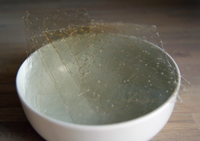
Photo from wikipedia
Hybrid gels can be used for controlled delivery of bioactives and for textural and rheological modification of foods. In this regard the hydrogel:oleogel ratio and gel development methodologies showed to… Click to show full abstract
Hybrid gels can be used for controlled delivery of bioactives and for textural and rheological modification of foods. In this regard the hydrogel:oleogel ratio and gel development methodologies showed to be the aspects that influence most of their properties. The present study shows how different fractions of oleogel can influence the hydrogel matrix of an oleogel-in-hydrogel emulsified system in terms of polymorphic arrangement, microstructure, texture and rheology. The hydrogel was prepared by using an aqueous sodium alginate solution and the oleogel was prepared through the gelation of medium chain triglycerides with beeswax. Hybrid gels were prepared under constant shearing. Crystallinity was clearly changed as hydrogel and oleogel were combined. No polymorphism was observed in the X-Ray diffraction of hybrid gels, as these showed homogeneous results for all component ratios. The behaviour of samples with increasing oleogel-to-hydrogel ratio presented a decrease of both firmness and spreadability, and then, a decrease of gel adhesivity and cohesiveness. This textural response was a consequence of the disaggregated structure, stemming from the disruption of the hydrogel network, due to the inclusion of increasing amounts of oleogel. Rheological results showed that all hybrid gels presented a gel-like behaviour (G´ > G´´). Oleogel's strength influenced the overall textural and rheological performance of hybrid gels. This work demonstrates the possibility of producing hybrid gels aiming to tailor texture on food systems.
Journal Title: Food research international
Year Published: 2019
Link to full text (if available)
Share on Social Media: Sign Up to like & get
recommendations!